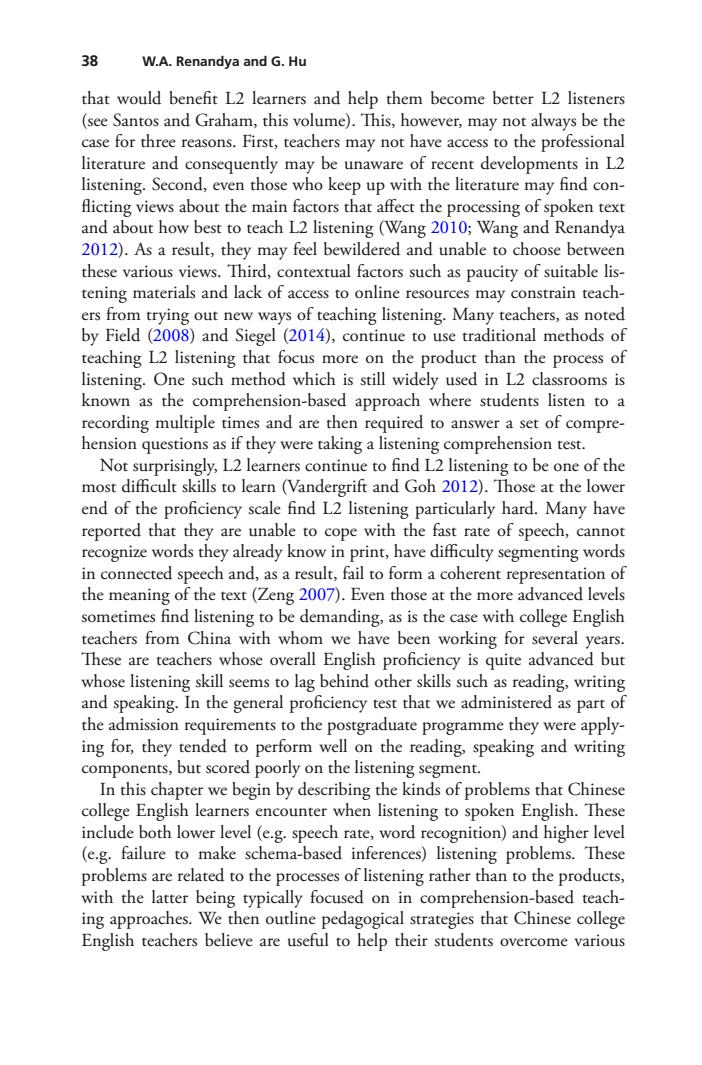正在加载图片...

38 W.A.Renandya and G.Hu that would benefit L2 learners and help them become better L2 listeners (see Santos and Graham,this volume).This,however,may not always be the case for three reasons.First,teachers may not have access to the professional literature and consequently may be unaware of recent developments in L2 listening.Second,even those who keep up with the literature may find con- flicting views about the main factors that affect the processing of spoken text and about how best to teach L2 listening (Wang 2010:Wang and Renandya 2012).As a result,they may feel bewildered and unable to choose between these various views.Third,contextual factors such as paucity of suitable lis tening materials and lack of access to online resources may constrain teach ers from trying out new ways of teaching listening.Many teachers,as noted by Field(2008)and Siegel (2014),continue to use traditional methods of teaching L2 listening that focus more on the product than the process of listening.One such method which is still widely used in L2 classrooms is known as the comprehension-based approach where students listen to a recording multiple times and are then required to answer a set of compre hension questions as if they were taking a listening comprehension test. Not surprisingly,L2 learners continue to find L2 listening to be one of the most difficult skills to learn (Vandergrift and Goh 2012).Those at the lower end of the proficiency scale find L2 listening particularly hard.Many have reported that they are unable to cope with the fast rate of speech,cannot recognize words they already know in print,have difficulty segmenting words in connected speech and,as a result,fail to form a coherent representation of the meaning of the text(Zeng 2007).Even those at the more advanced levels sometimes find listening to be demanding,as is the case with college English teachers from China with whom we have been working for several years These are teachers whose overall English proficiency is quite advanced but whose listening skill seems to lag behind other skills such as reading,writing and speaking.In the general proficiency test that we administered as part of the admission requirements to the postgraduate programme they were apply ing for,they tended to perform well on the reading,speaking and writing components,but scored poorly on the listening segment. In this chapter we begin by describing the kinds of problems that Chinese college English learners encounter when listening to spoken English.These include both lower level (e.speech rate,word recognition)and higher level (e.g.failure to make schema-based inferences)listening problems.These problems are related to the processes of listening rather than to the products, with the latter being typically focused on in comprehension-based teach ing approaches.We then outline pedagogical strategies that Chinese college English teachers believe are useful to help their students overcome various38 W.A. Renandya and G. Hu that would beneft L2 learners and help them become better L2 listeners (see Santos and Graham, this volume). Tis, however, may not always be the case for three reasons. First, teachers may not have access to the professional literature and consequently may be unaware of recent developments in L2 listening. Second, even those who keep up with the literature may fnd conficting views about the main factors that afect the processing of spoken text and about how best to teach L2 listening (Wang 2010; Wang and Renandya 2012). As a result, they may feel bewildered and unable to choose between these various views. Tird, contextual factors such as paucity of suitable listening materials and lack of access to online resources may constrain teachers from trying out new ways of teaching listening. Many teachers, as noted by Field (2008) and Siegel (2014), continue to use traditional methods of teaching L2 listening that focus more on the product than the process of listening. One such method which is still widely used in L2 classrooms is known as the comprehension-based approach where students listen to a recording multiple times and are then required to answer a set of comprehension questions as if they were taking a listening comprehension test. Not surprisingly, L2 learners continue to fnd L2 listening to be one of the most difcult skills to learn (Vandergrift and Goh 2012). Tose at the lower end of the profciency scale fnd L2 listening particularly hard. Many have reported that they are unable to cope with the fast rate of speech, cannot recognize words they already know in print, have difculty segmenting words in connected speech and, as a result, fail to form a coherent representation of the meaning of the text (Zeng 2007). Even those at the more advanced levels sometimes fnd listening to be demanding, as is the case with college English teachers from China with whom we have been working for several years. Tese are teachers whose overall English profciency is quite advanced but whose listening skill seems to lag behind other skills such as reading, writing and speaking. In the general profciency test that we administered as part of the admission requirements to the postgraduate programme they were applying for, they tended to perform well on the reading, speaking and writing components, but scored poorly on the listening segment. In this chapter we begin by describing the kinds of problems that Chinese college English learners encounter when listening to spoken English. Tese include both lower level (e.g. speech rate, word recognition) and higher level (e.g. failure to make schema-based inferences) listening problems. Tese problems are related to the processes of listening rather than to the products, with the latter being typically focused on in comprehension-based teaching approaches. We then outline pedagogical strategies that Chinese college English teachers believe are useful to help their students overcome various